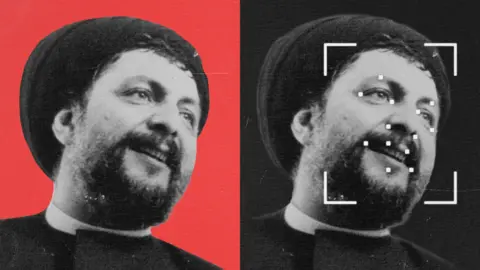A computer scientist at a university in the north of England is studying an image of a corpse—a mystery that has gripped the Middle East for nearly 50 years. Prof Hassan Ugail from Bradford University has created a digitized photo from a decomposed face found in a secret mortuary in Libya, identified as potentially belonging to Musa al-Sadr. Sadr vanished on the eve of the Iranian revolution, sparking countless theories about his fate, ranging from assassination to claims of him being alive.
Sadr's followers view his disappearance as a deeply emotional mystery, similar to the assassination of President John F. Kennedy. He was a pivotal figure in the Shia Muslim community, advocating for the rights of marginalized people in Lebanon. His mysterious fate echoes traditions in Shia Islam, where the concept of a 'hidden' imam plays a significant role.
Recent developments in facial recognition technology provide a hopeful outlook in identifying the body. The body reportedly bears similarities to Sadr, prompting new inquiries into his fate. Investigative team member Kassem Hamadé discovered remains in a Libyan morgue, raising questions of execution based on the condition of the skull.
The investigation, however, has not been free of peril. During attempts to gather information in Libya, the BBC team faced detention by local authorities, highlighting the controversial nature of Sadr's disappearance amidst inflammatory political ties.
Through advanced facial recognition, evidence suggests the body may very well be Sadr, yet many still cling to the belief that he survives. The ongoing struggle for the truth about Sadr's fate reflects the complexity of regional politics and the deep bond between him and his followers.
Sadr's followers view his disappearance as a deeply emotional mystery, similar to the assassination of President John F. Kennedy. He was a pivotal figure in the Shia Muslim community, advocating for the rights of marginalized people in Lebanon. His mysterious fate echoes traditions in Shia Islam, where the concept of a 'hidden' imam plays a significant role.
Recent developments in facial recognition technology provide a hopeful outlook in identifying the body. The body reportedly bears similarities to Sadr, prompting new inquiries into his fate. Investigative team member Kassem Hamadé discovered remains in a Libyan morgue, raising questions of execution based on the condition of the skull.
The investigation, however, has not been free of peril. During attempts to gather information in Libya, the BBC team faced detention by local authorities, highlighting the controversial nature of Sadr's disappearance amidst inflammatory political ties.
Through advanced facial recognition, evidence suggests the body may very well be Sadr, yet many still cling to the belief that he survives. The ongoing struggle for the truth about Sadr's fate reflects the complexity of regional politics and the deep bond between him and his followers.





















